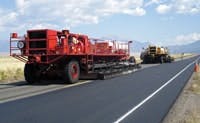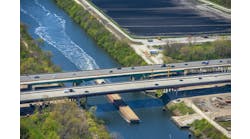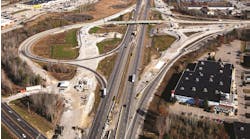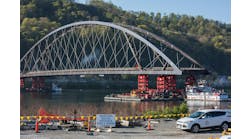State Highway 150 is not the most heavily traveled road.
In fact, its annual average daily traffic is less than 1,000 vehicles. But the Colorado Department of Transportation (CDOT) agreed to try a relatively new repaving method on 16.5 miles of the road where it leads into the Great Sand Dunes National Park.
The result won the Roads & Bridges/Asphalt Recycling & Reclaiming Association Recycling Award in the hot in-place recycling (HIR) category.
The short paving season in the area of the park, in the Rocky Mountains 35 miles northeast of Alamosa, Colo., meant that Cutler Repaving Inc. didn’t start the work until July 2009.
The crew used preheaters to raise the temperature of the existing pavement to about 300°F so a scarifier could tear up the top 1 in. The torn-up material was picked up, mixed with a rejuvenating agent and laid back down with the same machine as a leveling course. The single-pass machine, which was custom-manufactured by Cutler specifically for hot in-place recycling, then laid a 1-in. surface course of virgin hot-mix asphalt (HMA) over the top.
“It’s all in the same train,” Keith Magowan, P.E., project engineer for CDOT, told Roads & Bridges. “It really works out nice for us, because we can limit our traffic control to a quarter of a mile at a time. Because of our traffic out there, we shut down a mile at a time, but if we were to do this in more of an urban area, we could shut it down to a quarter of a mile at a time and just bump the traffic up as we go.”
Magowan had an easy commute to the jobsite, since he lives about a mile away, and possibly the most picturesque commute in the country. The location is one of the largest Alpine valleys in the world, at an elevation of about 8,000 ft, with lots of piñon trees. It’s also an extremely dry area, with only 7-8 in. of rain a year at the valley floor.
The dryness contributes to the accumulation of sand that makes the sand dunes possible. The other major contributing factor is the high winds, Magowan said, which scour the land and also keep the giant sand dunes in constant motion.
Trying out new material
Climate was one of the factors Mike Coggins considered when he decided to try Cutler’s repaving process on S.H. 150. Coggins is the regional materials engineer for CDOT’s Region 5. CDOT had successfully used the process on a project in Region 3 in the Grand Junction area, so Coggins was on the lookout for another project where
the single-pass HIR process might be a success.
“We were able to recycle a significant portion of the existing roadway,” Coggins told Roads & Bridges, “and then add new asphalt to the top in order to improve the structural integrity of this roadway.”
CDOT designed the S.H. 150 project as a recycling project from the start, so it needed no change orders to use the new process the way Cutler did.
“We wanted to try this and wrote the specifications for this method,” Coggins said.
Lawrence, Kan.-based Cutler was a subcontractor to A&S Paving, based in Canyon City, Colo. A&S was the general contractor on the project and provided the HMA. CDOT had a quarry pit near the middle of the project, where A&S set up a hot-mix plant and had a maximum haul distance of about 7 miles. Cutler performed the repaving operations. Work Zone Traffic Control, based in Pueblo, Colo., handled the traffic control for the project.
S.H. 150 had a 4-in. aggregate base and 3.5 in. of HMA when Cutler arrived.
“We picked up the top inch,” said Coggins, “whether that was chip-seal material, whether that was crack-fill material, whether it was old, oxidized hot-mix asphalt. And then we add a rejuvenating agent that kind of brings that binder back to life. It takes care of the reflective cracking that usually is the first thing that leads to deterioration of the highway.”
Mixing the rejuvenating agent with the scarified pavement restores the viscosity of the aged asphalt. The single-pass repaving machine’s recycling screed then puts the recycled mix back down as a leveling course.
The Cutler machine, named the 2500 Series Repaver, immediately covered the recycled HMA with 1 in. of virgin HMA with a 0.5-in. nominal rock size and PG 58-28 binder, which is the recommended binder for the local climate. The repaved road has a thickness of 8.5 in.
The 1-in. recycled course and the 1-in. virgin course are treated as a single 2-in. thickness for compaction, according to John Miles, vice president of operations at Cutler. The paving crew used an Ingersoll Rand DD118 in vibratory mode as a breakdown roller, followed by a PT125 pneumatic-tire roller. Finish rolling also was done with a vibratory steel-drum roller.
Smooth customer
One of the extraordinary aspects of the S.H. 150 project was the smoothness of the finished pavement. The roadway had an international roughness index (IRI) of 88 in./mile before repaving and an IRI of 38 after, a huge improvement for just taking off 1 in. and putting back a total of 2 in. The improvement reaped 91% of the possible smoothness bonus.
Miles attributed the smoothness to using a material transfer vehicle, another machine that Cutler custom-built.
“The one that we use is custom-manufactured, because it also has a heating hood on it, because we’re trying to do everything we can to get more heat into the road,” Miles told Roads & Bridges. “We call it a PCV, which is a preheater conveyor vehicle. It was operating right in front of the repaver,” heating the pavement and delivering the virgin HMA to the front of the repaver. The HMA is then conveyed to the back of the repaver, where it is laid with a standard hot-mix screed.
Using the PCV “eliminates contact between the truck and the paving machine,” added Miles. “It eliminates segregation, because it has mixing augers in it, both thermal and granular segregation.”
The completed pavement’s smoothness took CDOT by surprise.
“I was planning on using some of that [incentive] money for the smoothness payout to level up the road a little bit and improve the cross slope on there,” said Magowan. “I got surprised on that and had to change my mind.”
The repaving of S.H. 150 was completed in September 2009 at a cost of $2.9 million.
“It worked out just exactly how it was supposed to work out,” said Magowan.
“I think that recycling asphalt pavements is part of the future that we have to take and embrace,” said Coggins. “That is what I will attempt to do at every given opportunity. This is at the top of the list as far as successful rehabilitation methods of reconstruction, and I would like to see it continue.”



